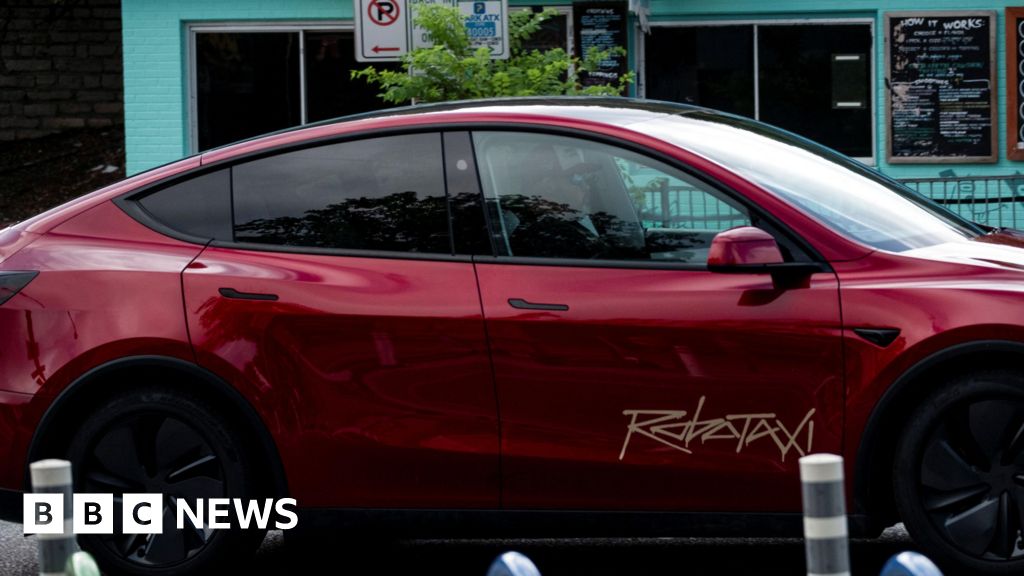Tesla’s long-awaited robotaxis rolled out for the primary time on roads in Austin, Texas on Sunday.
In movies shared by Tesla on X, a small group of invited analysts, influencers and shareholders had been proven taking part in paid rides.
The small variety of autos deployed had a human security operator within the passenger seat, in line with studies.
Analysts stated the “low-key” robotaxi launch highlights Tesla’s huge bid to compete with current self-driving taxi operators within the US and China, because the sector grows.
Musk congratulated Tesla’s synthetic intelligence and chip design groups on the launch in a post on X, writing that it was “fruits of a decade of exhausting work”.
“Each the AI chip and software program groups had been constructed from scratch inside Tesla,” he added.
Forward of Sunday’s pilot, he stated in a jokey put up that prospects would pay “a $4.20 flat payment” for rides in Tesla robotaxis.
The small fleet of autos don’t but embody the Cybercab – the futuristic car concept unveiled by Musk at Tesla’s “We, Robot” event in October – which Musk says would be the firm’s driverless taxi sooner or later.
As an alternative it was current Tesla autos, with a small “robotaxi” emblem on the aspect, that took to Austin streets on Sunday.
Forrester analyst Paul Miller described the launch of the pilot as a “low-key affair”.
“As anticipated, solely a handful of autos can be found proper now, they solely function in a small a part of town and there is a security driver within the car in case it encounters conditions it can not deal with autonomously,” he stated.
However he added that the transfer highlighted the corporate’s ambitions to rival companies already providing driverless ride-hailing within the US and world wide.
Waymo, owned by Google mother or father Alphabet, together with Amazon’s Zoox, already supply self-driving taxi rides in Austin, in addition to in San Francisco, California, and Phoenix, Arizona.
In the meantime Uber, which recently announced it would bring forward trials of driverless taxis in the UK, has partnered with Chinese language companies Pony.AI, WeRide and Momenta to carry autonomous ride-hailing to extra cities outdoors the US and China.
Mr Miller stated Tesla is betting that the amount of automobiles it delivers, information it has from autos and cheaper, camera-based self-driving tech “will permit it to return from behind and pull forward” of rivals.
However he added that its means to compete, significantly with Chinese language companies dominating the sector, will rely upon enchancment of its superior assisted driving system – which Tesla calls Full Self-Driving (FSD).
FSD has been topic to probes by US auto regulators and complaints from prospects about its security.
“If that FSD system is not an enormous leap ahead from the motive force help tech that consumers of normal Teslas already use in some international locations, it’ll want numerous distant monitoring and management from a military of teleoperating security drivers,” Mr Miller stated.
“This can add to Tesla’s prices, and supply loads of alternatives for embarrassing movies of Tesla robotaxis doing bizarre issues.”
It comes as numerous operators eye the rising marketplace for driverless taxis.
German automotive maker Volkswagen believes it may swell to €450bn in measurement by 2035, according to a recent report by Fortune magazine.
However the rise of self-driving automobiles and ride-hailing companies on US roads has additionally been met with some scepticism over their security.
Tesla stated in a put up on its X account on Monday that its robotaxi service “will drastically enhance security for susceptible highway customers, corresponding to pedestrians & cyclists”.
The US Nationwide Freeway Visitors Security Administration is reportedly reviewing info from Tesla concerning the security of its self-driving taxis in dangerous climate, following a request in Could.
Basic Motors pulled the plug on its Cruise robotaxi project in December after accidents involving its self-driving autos.
The corporate additionally cited the more and more aggressive market as a motive for suspending its ride-hailing initiative.

